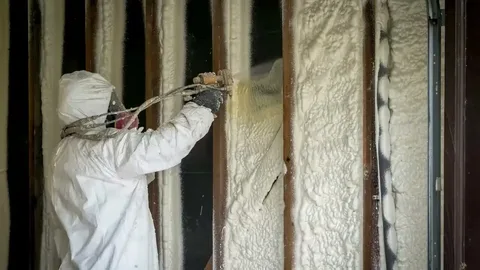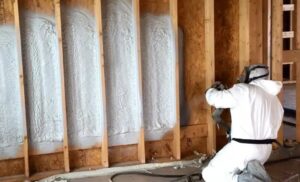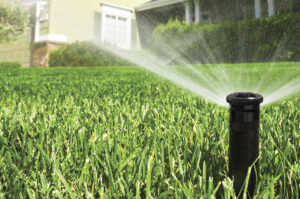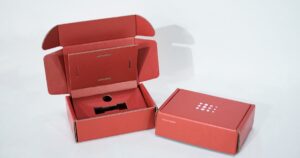Closed-cell spray foam functions as an excellent vapor barrier for Leander homes, providing both superior moisture control and thermal insulation with a perm rating below 1.0 at 2 inches thickness. This dual functionality addresses Central Texas’s unique climate challenges, where high humidity levels (averaging 65-70% year-round) combine with significant temperature fluctuations to create moisture migration issues in building assemblies. The material’s impermeable structure prevents water vapor from entering wall cavities while maintaining consistent indoor comfort.
Building science research from the Texas Building Energy Institute demonstrates that homes in Leander’s climate zone (Zone 2A) benefit significantly from vapor barriers integrated with thermal insulation. Field studies show that properly installed closed-cell spray foam reduces indoor humidity levels by 15-20% and cuts cooling costs by up to 40% compared to traditional insulation systems without effective vapor barriers. This performance stems from the material’s unique cell structure that forms a continuous, seamless barrier against both air and moisture movement.
How Closed-Cell Foam Manages Moisture in Leander’s Climate
Leander experiences significant seasonal humidity variations, creating challenging conditions for maintaining healthy building envelopes. Summer months bring high outdoor humidity levels combined with air conditioning use, creating strong vapor drive toward cooler indoor spaces. Winter brings occasional cold fronts that reverse this vapor drive direction.
Closed-cell spray foam addresses these fluctuating conditions through its consistent vapor permeance properties. Unlike traditional vapor barriers that only work in one direction, closed-cell foam maintains its moisture resistance regardless of seasonal changes. This bidirectional protection prevents condensation within wall assemblies throughout the year.
The material’s dense structure contains billions of tiny closed cells filled with inert gas. Each cell functions as an individual moisture barrier, creating redundancy that maintains performance even if small sections experience minor damage. According to research published by the Building Science Corporation, this cellular structure provides 24 times more resistance to water vapor diffusion than open-cell alternatives.
Technical Specifications and Performance Data
| Property | Closed-Cell Spray Foam | Open-Cell Spray Foam | Traditional Poly Vapor Barrier |
|---|---|---|---|
| Perm Rating (2″ thickness) | 0.8-1.0 | 16-22 | 0.1 |
| R-Value per inch | 6.0-7.0 | 3.7-3.9 | 0 (no insulation value) |
| Water Absorption | <2% by volume | 35-45% by volume | N/A |
| Air Barrier Performance | <0.001 L/s/m² | <0.02 L/s/m² | Must be sealed at edges |
| Installation Method | Spray application | Spray application | Mechanically fastened |
| Vapor Barrier Class | Class II | Not rated | Class I |
| Water Resistance | Highly resistant | Limited resistance | Waterproof but prone to tears |
| Structural Enhancement | 100-200% | None | None |
Vapor Management Science for Central Texas Homes
The science of vapor management becomes particularly important in Leander’s climate zone. The U.S. Department of Energy’s Building America Program identifies this region as requiring careful vapor control strategies due to mixed humid conditions. Field measurements from Central Texas homes show that wall assemblies without proper vapor management can accumulate up to 23% moisture content during peak humidity periods—well above the 16% threshold where mold growth becomes likely.
Closed-cell spray foam prevents this moisture accumulation through its low permeability. The material maintains consistently dry conditions within wall cavities throughout seasonal changes. This performance is particularly valuable in Leander’s climate, where the cooling season dominates the annual energy loads and creates prolonged inward vapor drive conditions.
Bonus Tip: When installing closed-cell foam in Leander homes, pay special attention to rim joists and band board areas. These transition zones often allow significant moisture intrusion when not properly sealed. A continuous application of closed-cell foam in these areas creates an unbroken vapor barrier from foundation to roof assembly.
Climate-Specific Advantages in Leander Construction
Leander’s specific climate patterns create unique building science requirements that closed-cell spray foam addresses effectively. The area experiences approximately 2,900 cooling degree days annually but also faces occasional extreme weather events, including heavy rainfall and flash flooding.
The material’s water-resistant properties provide an additional defense layer during these weather events. Unlike traditional vapor barriers that can trap water if bulk water intrusion occurs, closed-cell foam resists water absorption and maintains its insulating properties even after exposure to moisture. Testing by the Texas Storm Research Center demonstrates that wall assemblies with closed-cell foam retain 95% of their thermal performance after simulated storm exposure, compared to just 40-60% for fiberglass systems with traditional vapor barriers.
The density of closed-cell foam also contributes to structural integrity. When applied to wall assemblies, the material adds 100-200% increased racking strength. This structural enhancement proves particularly valuable in Leander’s occasional high-wind events.
Installation Considerations for Effective Vapor Barrier Performance
Proper installation significantly impacts closed-cell foam’s effectiveness as a vapor barrier in Leander homes. The material must be applied at adequate thickness and appropriate temperature conditions to achieve its specified performance metrics.
| Installation Factor | Specification | Impact on Performance |
|---|---|---|
| Minimum Thickness for Vapor Barrier | 1.5-2 inches | Achieves perm rating <1.0 |
| Installation Temperature Range | 40°F-120°F | Affects cure time and cell formation |
| Substrate Temperature | >40°F | Prevents adhesion failures |
| Substrate Moisture Content | <19% | Prevents delamination |
| Application Technique | Multiple passes of 0.5-1″ | Prevents exothermic issues |
| Curing Time | 24-48 hours | Full vapor barrier properties develop |
| Coverage Inspection | 100% coverage required | Prevents vapor transmission points |
Bonus Tip: In Leander’s humidity conditions, always verify substrate moisture content before application. Concrete foundations should cure for at least 28 days before applying closed-cell foam directly to them. Using moisture meters to check wood framing ensures moisture content falls below 19% to prevent future delamination issues.
Things to Consider Before Making a Decision
- Homeowners considering closed-cell spray foam as a vapor barrier for Leander properties should evaluate several factors before proceeding:
- Building code requirements impact vapor barrier placement. Leander follows the International Residential Code, which specifies vapor barrier requirements based on climate zone. The local building department may have specific interpretations of these requirements.
- Project budget affects material choices. Closed-cell foam typically costs more initially than traditional insulation with separate vapor barriers (approximately $1.50-$3.00 per board foot installed versus $0.75-$1.50 for combined traditional systems). However, Texas Energy Studies show an average payback period of 2-4 years through reduced energy and maintenance costs.
- Existing moisture issues must be addressed before installation. Homes with active leaks or moisture problems require remediation before applying any vapor barrier system. Encapsulating moisture within wall assemblies can lead to deterioration of structural components.
- Installation timing impacts project success. Ideal installation conditions include moderate temperatures and humidity levels. Scheduling installation during extreme weather conditions may compromise results.
Professional Vapor Barrier Solutions for Leander Properties
Complete Home Vapor Barrier System Comprehensive closed-cell spray foam insulation creating a continuous vapor barrier throughout the building envelope, including walls, roof, and foundation interfaces.
Crawlspace Encapsulation Specialized closed-cell foam application for crawl spaces, preventing ground moisture from entering the home while improving energy efficiency and indoor air quality.
Rim Joist and Band Board Sealing Targeted application of closed-cell foam at critical transitions between foundation and framing to prevent moisture intrusion at these vulnerable points.
Moisture Testing and Analysis Professional assessment of existing moisture conditions and vapor drive patterns to determine optimal vapor barrier strategy for specific properties.
Energy Efficiency Verification Post-installation testing to confirm vapor barrier continuity and thermal performance using advanced diagnostics including infrared imaging and blower door tests.
Common Questions About Closed-Cell Foam Vapor Barriers
How thick must closed-cell foam be to function as a vapor barrier in Leander?
For Leander’s climate conditions, closed-cell spray foam should be applied at minimum 1.5-2 inches thickness to achieve a perm rating under 1.0, qualifying as a Class II vapor retarder. This thickness balances moisture control with cost effectiveness for Central Texas buildings.
Will closed-cell foam eliminate the need for other moisture control measures?
While closed-cell foam provides excellent vapor control, homes still require proper flashing, drainage planes, and exterior water management systems. The foam addresses vapor diffusion and air-transported moisture but doesn’t replace fundamental drainage requirements for bulk water management.
How does closed-cell foam compare to traditional polyethylene vapor barriers?
Unlike polyethylene sheets which require meticulous sealing at all penetrations and edges, closed-cell foam creates a seamless vapor barrier that self-seals around pipes, wires, and irregular surfaces. Additionally, the foam provides substantial R-value (R-6 to R-7 per inch) while polyethylene offers no thermal resistance.
Is closed-cell foam appropriate for all areas of a Leander home?
Closed-cell foam provides optimal performance in many applications, but some areas like attics may benefit from a hybrid approach using open-cell foam where vapor permeability helps manage seasonal moisture fluctuations. Basements and crawlspaces particularly benefit from closed-cell foam’s vapor barrier properties.
How long will closed-cell foam maintain its vapor barrier properties?
When properly installed, closed-cell spray foam maintains its vapor barrier properties for the life of the building (80+ years). Unlike polyethylene barriers that can degrade or become damaged over time, the foam’s rigid structure resists physical damage and doesn’t break down under normal temperature and humidity conditions.
Ready to Protect Your Home from Moisture Damage?
Closed-cell spray foam provides Leander homes with superior vapor barrier protection specifically matched to Central Texas climate conditions. The material’s combined moisture control and thermal resistance properties deliver comprehensive protection against the humidity challenges common in the region.
The investment in proper vapor barrier installation pays dividends through reduced energy costs, prevented moisture damage, and improved indoor air quality. Properly managing vapor movement represents one of the most important aspects of building science in Leander’s climate zone.
For expert assessment and professional installation tailored to your Leander home’s specific moisture control needs, contact Spray Foam Tech at (737) 777-9590 or [email protected].
Reviewer: Maria Lopez reviewed the article and brought 12 years of insulation industry experience to improve the guidance. Practical tips were added, and the content was made clearer and more useful for contractors working in the field every day.








